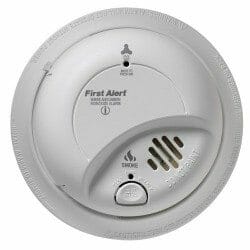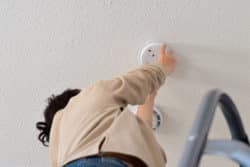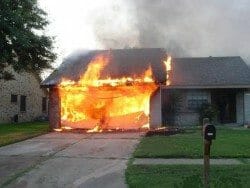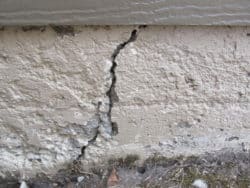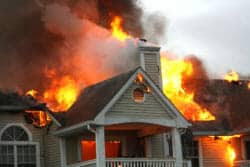Is A Carbon Monoxide Alarm Required In a Bedroom
Home » Interior » Alarms: Smoke & CO »
The short answer is yes, if there is a fossil fuel burning appliance, like a fireplace, in the bedroom or an attached bathroom with a fireplace. This protects occupants who sleep with their bedroom door closed.
The IRC Code, International Residential Code, R315.3
“Carbon monoxide alarms in dwelling units shall be installed outside of each separate sleeping area in the immediate vicinity of the bedrooms. When a fuel-burning appliance is located within a bedroom or its attached bathroom, a carbon monoxide alarm shall be installed within the bedroom.”

Wood or gas burning fireplace are one of the most common fossil fuel appliances found in bedrooms or bathrooms and they produce carbon monoxide.
At times, states or building jurisdictions modify codes, have special ordinances or requirements applicable to certain geographic areas. Contacting the local building department can usually answer your questions and inform you about the local codes and requirements.
Can you use a combination smoke alarm and carbon monoxide alarm?
Yes. Combination carbon monoxide/smoke detectors shall be permitted to be installed in carbon monoxide detection systems in lieu of carbon monoxide detectors, provided they are listed in accordance with UL 2075 and UL 268. (R315.6.4)
Remodeling Warning
Paint or varnish removers
Paint and varnish removers may have chemicals such as Methylene chloride, a solvent commonly found in paint and varnish removers. The fumes from this solvent may (metabolize) or turn into carbon monoxide when inhaled. Basically, these fumes may cause carbon monoxide poisoning in a human body.
Gas generators used in indoor spaces
When remodeling homeowners or contractors may use gas powered generators for electric power in the process. The exhaust fumes from these generators contain carbon monoxide and when used in enclosed spaces, rather than outside, they may also cause carbon monoxide poisoning.
Health issues range from minor to death
Carbon monoxide poisoning is caused by inhaling combustion fumes. When too much carbon monoxide is in the air you’re breathing, your body replaces the oxygen in your red blood cells with carbon monoxide. This prevents oxygen from reaching your tissues and organs.
Symptoms of carbon monoxide poisoning:
- Dull headache
- Weakness
- Dizziness
- Nausea or vomiting
- Shortness of breath
- Confusion
- Blurred vision
- Loss of consciousness
One of the most serious risk of carbon monoxide poisoning is irreversible brain damage or even dying before anyone realizes there’s a problem.
Health complications associated with carbon monoxide poisoning
Depending on the degree and length of exposure, carbon monoxide poisoning can cause:
- Permanent brain damage
- Damage to your heart, possibly leading to life-threatening cardiac complications
- Fetal death or miscarriage
- Death
What you should do to protect yourself
- Test your carbon monoxide alarms every month and test them per manufacture’s recommendations.
- Inoperative ones should be replaced. If newer and the battery is dead, then replace the battery with a 10 year battery.
- Ones that are painted over, damaged, dusty or greasy may fail. Replacement is recommended.
- Ones that are over 7 years old generally should be replaced. Many professionals recommend this, even though there are those that say you may wait until it is 10 years old.
- If one is inoperative and it’s hardwired in, then replace it with the same brand and model as the other carbon monoxide alarms in the home. Not doing so may result in the new alarm failing or the older ones failing because of communication issues between unlike alarms.
- Note, that many experts recommend that all alarms be replaced, even though only one is inoperative; for they say it may be only a matter of time before others fail.

Carbon monoxide is a colorless, odorless, tasteless gas and may go undetected if there are not functioning carbon monoxide alarms located in the proper locations; for an improper location can affect the performance and the sensitive electronic components in an alarm. Emergency professionals can tell you that carbon monoxide alarms are one of the home safety issues that often gets overlooked or put off checking and correcting until another day.


